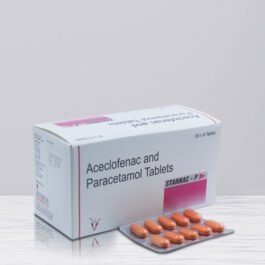STARNAC Hot Gel
An Exhilarating Liniment to Wipe-out Strain and Pain
COMPOSITION – Aceclofenac IP 1.5% w/w + Linseed Oil BP 3% w/w + Methyl Salicylate IP 10% w/w + Benzyl Alcohol BP (as preservative) 1% w/w + Capsaicin USP 0.025%w/w + Menthol IP 5%w/w + Gel base
Description
Topical administration of therapeutic agents offers many advantages over oral and intravenous administrations. Hydrogel based drug delivery system is a most promising novel approach now-a-days for the delivery of the drug for an extended period of time.
Topical therapy is not only promising on the safety and efficacy fronts but also on the economic fronts too.
- Aceclofenac (NSAID of BCS Class II)
- Including aceclofenac in gel-based drugs avoids gastric side effects. Chances of drug-drug interactions will be minimized by topical administration of ACE.
- Aceclofenac ointment showed good pH value, spreadability, good entrapment efficiency. J. of Drug Delivery & Therp. 2021; 11(5):71-79
- Linseed oil (Drying oil)
- Reduced joint swelling and circulating TNF (tumor necrosis factor) alpha level in both preventive and curative protocols of arthritis.
- Inhibits arachidonic acid (inflammatory mediators) induced inflammation.
- Methyl salicylate (Counterirritant)
- A plant-derived natural product isolated from Ilex Chinensis (a folk herbal medicine plant native to China) used as an analgesic.
- Could effectively facilitate the transdermal permeation of most low molecular weight components of herbal preparations for external use.
- Benzyl Alcohol
- An aromatic chemical compound used for the improvement of active substance solubility and added as anti-bacteriostatic compound. EMA/CHMP/272866/2013
- Capsaicin
- Topical capsaicin 8% patches provide moderate pain relief for patients suffering from chronic neuropathic pain and are well tolerated compared with centrally acting oral agents.
- Menthol (Counterirritant)
- Menthol, after topical application, causes a feeling of coolness due to stimulation of ‘cold’ receptors by inhibiting Ca++ currents of neuronal membranes that are endowed with analgesic properties.





